Since 3rd Degree has moved a couple of times, this post keeps getting lost in the void. Over the years it’s been by far the most asked for, requested, and clicked on things I’ve ever written.
I first wrote this piece back in January of 2009, re-wrote it in 2013, again in 2017 as part of 3rd Degree’s 20th birthday celebration, and last year in 2019 with the move to the new independent site. With the current pause for Covid-19 I figured I could refresh it again for 2020.
Every time I re-do this post – this is the 5th pass of it – I’ve learned more and read more stories that I try and include. Hopefully, each time this piece gets better. I do update and freshen the lists of players with current players while still keeping old famous examples.
I happen to take numbers very seriously, to me they have meaning. I have strong ideas about what should be worn and by whom. I think they are important.
Except they’re not. Wear what you want.
But if you’re trying to pick a number for yourself, or trying to understand why a pro wears what he does, then maybe this will help you by learning some history and meaning for the numbers.
A Brief History of Numbers
When our modern sports formed ages ago jerseys didn’t have numbers on them. Or names for that matter. Over time numbers were added to jerseys so fans and media could tell who players were from high in the stands.
The earliest soccer numbers were handed out based on the lineup. The starting eleven players wore numbers 1 to 11, starting with the keeper as the #1 and moving from the back to the front and right to left.
To make a long story short, the most common formation when numbering was beginning to be used was the 2-3-5.
Yes, that’s two defenders (#2, #3), three midfielders (#4, #5, #6), and five strikers (#7, #8, #9, #10, #11). Although some countries didn’t use numbers until the W-M was in vogue, which makes some small differences.
Every sport has a history with numbers. In the early days of baseball, the batting order wore numbers 1 to 9 based on the place they hit in the order. Babe Ruth wore 3 and Lou Gehrig 4 because they hit 3rd and 4th in the Yankee order. In college basketball – less so in the pros – numbers are mostly combinations of 0 to 5 like 5, 11, 23, 32, 41, etc. In American football, numbers indicate what position you play. Linebackers are 40s/50s, receivers used to be just 80s but now are also 1 to 19, running backs and DBs are 20s/30s/40s, etc.
In soccer as the shape of formations changed and evolved over the years the numbers moved in certain patterns depending on the country in which the evolution was taking place, particularly on defense chaos sometimes reigned. Numbers took on a positional meaning that could slowly change over the decades and might have different meanings depending on in which country you are asking.
When substitutes were allowed in soccer (originally there was no subbing) the subs would wear numbers starting at 12 and going up to 17 or so, depending on how many bench players were allowed.
People have written entire books on the evolution of tactics and you can spend a lifetime studying it. I’m going to try and explain it in a couple of paragraphs and won’t be doing it real justice.
I personally recommend The Simplest Game: The Intelligent Fan’s Guide to the World of Soccer by Paul Gardner or Inverting the Pyramid by Jonathan Wilson for a far greater dissertation on the evolution of tactics.
In the modern era with the advent of television, the marketing of players, and the sales of jerseys, teams began to assign specific numbers to players for an entire season. Numbers began to become synonymous with players and names started appearing on the back of kits. Amazingly, a few leagues didn’t adopt the one number per player as a rule until the mid-90s.
In general terms, 1 to 11 remain the most coveted numbers. They are the pure, classic numbers of superstars and the soccer gods. In modern times the numbers in the teens and low 20s have become sought after due to 23 man world cup rosters.
Only in the last ten to fifteen years with the advent of the massive squads of large teams have we begun to see numbers in the 30s and 40s come into play. As examples, Spain by rule uses numbers 1 to 25 and France 1 to 30.
With the more recent aberrations of media hype and marketing strangeness, we see numbers like 66 and 99 in countries without number rules.
Let’s run through them.
1 to 11
The old school starting numbers, the most coveted and sought after numbers from the history of the game.
1 – Goalkeeper
Probably the most pristinely ubiquitous number in soccer is the #1 for the keeper. You just don’t see a field player wear this number. Ever. The 1 is the keeper, period. This rule should never, ever be broken*.
In fact, in some countries, the #1 kit is a keeper jersey by rule.
*Side Note: Yet this rule was broken and worn in the field. In the 70s, a few countries wore jerseys numbers based on their alphabetical roster, notably Argentina and the Netherlands, so you saw field players with the 1 in the World Cup. I shudder to think of it.
World: Peter Schmeichel, Lev Yashin, José Luis Chilavert, Oliver Kahn, Iker Casillas, Gianluigi Buffon, David de Gea, Manuel Neuer. Pretty much any first-choice keeper.
USA: Brad Friedel, Tim Howard.
FCD: Mark Dodd, Matt Jordan, Kevin Hartman, Jesse Gonzalez.
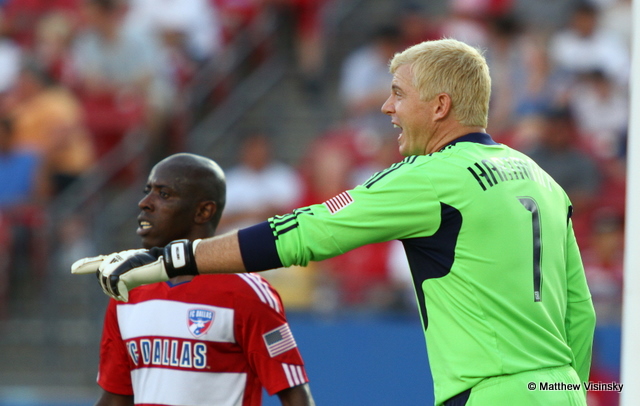
Usage that makes my head hurt: Any field player wearing #1. That’s just wrong.
FCD Side Story: When Dario Sala joined FC Dallas he and Jeff Cassar both asked for the #1 jersey after Scott Garlick retired. Colin Clark decided that rather than picking someone for the #1 he would let neither have it until one of them won the job outright. Sala stayed with his higher 48 and then 44 even when Cassar was gone.
2 – Right Back
Almost always a defender, and almost always the right back. The #2 has been the right-sided defender since numbers were added to the game and never moved. It does pop up in the middle of the defense on very rare occasions.
World: Dani Alves (w/ Brazil), Dani Carvajal, Cafu, Gary Neville, Ivan Cordoba
USA: Frankie Hejduk, DeAndre Yedlin
MLS: Tony Beltran, Jonathan Spector
FCD: Eric Dade, Cory Gibbs, Reggie Cannon, Hernan Grana.
Usage that makes my head hurt: Clint Dempsey’s adoption of the “Duce” moniker and the no. 2 jersey. He wore it as a kid and at Furman then carried it over to MLS. With the US, Dempsey wore the proper 8.
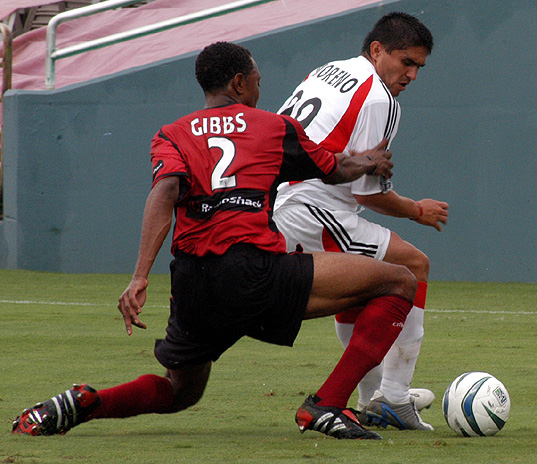
3 – The Defender’s Defender
The purest pure defender, usually a center back and has been so since the earliest days when along with the no. 2 it was the first pair of defender numbers.
Side note: Although Brits seem to think the 3 is a left back because for them the 5 and/or 6 dropped into the backline between the 2 and 3. Rather than the 3 staying in the middle of the defense with the 4 – or the 6 in South America – dropping wide left. I know, brits are funny.
World: Pablo Maldini, Jaap Stam, Pique, Giorgio Chiellini, Ashley Cole, Lucio
USA: Gregg Berhalter, Carlos Bocanegra, Omar Gonzalez, Matt Miazga
MLS: Drew Moor, Ike Opara, Michael Parkhurst
FCD: Ryan Suarez, Carey Talley, Greg Vanney, Ugo Ihemelu, Reto Ziegler
Usage that makes my head hurt: Ex-MLSer Calen Carr was a striker who wore the #3.
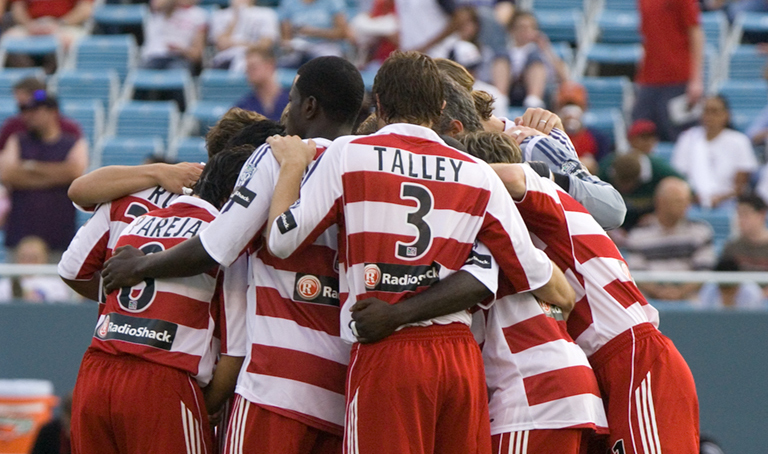
4 – The Shifter
This number is often a defender or wingback and occasionally a midfielder depending on the country or culture. 4 started on the right side of midfield so it is often thought of as a flank player, but can also be seen as a center back in many places… or as a holding mid if your British (see below the 5/6 being center backs in the UK).
As it was frequently one of the original three midfield numbers (4, 5, 6) that were shifted into the backline it’s commonly a defender’s number.
FCD Side Note: For FC Dallas #4 has been a left back fairly frequently.
World: Javier Zanetti, Sergio Ramos, Pep Guardiola, Patrick Vieira, Ivan Rakitic, Jurgen Kohler, Claude Makelele, Frank de Boer, Frank Rijkaard
USA: Michael Bradley, Tyler Adams
MLS: Tyler Adams, Marvell Wynne, Greg Garza.
FCD: Chris Gbandi (LB), Paul Broome (LB), Diego Sonora (RB), Andrew Jacobson (CM), Bressan (CB)
Usage that makes my head hurt: Cesc Fabregas wears #4. According to Wikipedia, Fabregas idolized Barcelona’s captain #4 Pep Guardiola, who would later give Fàbregas his shirt as consolation when Fàbregas’ parents divorced.
5 – Center Half
The #5 started as the central half in the 2-3-5 and in most places has stayed there.
In the US a “center half” remains a midfielder; in England, a “center half” is a central defender; in both places, the #5 is still often a center half. In South America, the 5 often stayed in the midfield as well.
So cultural background can dictate a lot in how this number is perceived in the midfield versus defense debate… but it’s almost universally central.
World: Rio Ferdinand, Fabio Cannavaro, Carlos Puyol, Franz Beckenbauer, Sergio Busquets, Zinedine Zidane (w/ Madrid)
USA: Thomas Dooley, John O’Brien, Oguchi Onyewu, Matt Besler
MLS: Kyle Beckerman, Matt Besler
FCD: Lubos Kubik, Steve Jolley, Marcelo Saragosa, Tenywa Bonseu, Thiago Santos
Usage that makes my head hurt: Jair Benitez wore #5 for FCD as a left back. Boo, Jair, boo.
6 – Mr. Versatility
Perhaps more than any other number the 6 can pop up in multiple locations all over the field depending on your culture. Like the 5, the 6 started out as a midfielder and in many soccer cultures, it stayed there. Mostly a central player’s number, not typically a flank player.
In the US, for example, this number is so completely ingrained as the holding-mid that we call the position “the 6.” We define a normal 4-3-3 midfield these days as a combo of 6-8-10.
In England, the 6 mostly migrated to center back dropping between the 2 and 3. In South American, notably Brazil, it migrated to left back or wingback.
Side Note: The no. 6 is my number.
Defense
World: Franco Baresi, Roberto Carlos, Marcelo (w/ Brazil), Bobby Moore, Tony Adams
USA: Steve Cherundolo, John Brooks.
MLS: Jay Heaps, Kofi Opare, Alexander Callens.
FCD: Steve Morrow, Tom Soehn.
Midfield
World: Cristiano Zanetti, Xavi, Paul Pogba, Ronald de Boer, Matthias Sammer
USA: Brandi Chastain, Maurice Edu, Darlington Nagbe
MLS: Osvaldo Alonso, Darlington Nagbe, Shea Salinas
FCD: Ronnie O’Brien, Pablo Ricchetti, Jackson, Lazo Alavanja
Usage that makes my head hurt: Anibal Chala being assigned the #6 for FC Dallas for an entire season without actually being here in Dallas.

7 – Right Wing
The #7 is known worldwide as an attacking number worn by a player with flare usually playing out wide, in particular on the right wing. 7 started as the right wing across the front 5 and pretty much stayed there.
It can occasionally be left or even central depending on club and country, but it feels better on the right.
Side Note: The history of the #7 at Manchester United alone is staggering: Jimmy Delaney, George Best, Bryan Robson, Eric Cantona, David Beckham, Michael Owen, and Christian Ronaldo… to name a few. Reinforcing why we don’t retire numbers in soccer.
World: Luis Figo, David Villa, David Beckham, Cristiano Ronaldo, Raul, Kenny Dalglish, Eric Cantona, Johann Neeskens, Andriy Shevchenko
USA: Demarcus Beasley, Eddie Lewis, Bobby Convey
MLS: Cristian Roldan, David Villa, Josef Martinez
FCD: Mark Santel, Dave ven den Bergh, Jesus Ferreira, Eddie Johnson.
Usages that makes my head hurt: Carlos Gruezo while at FC Dallas. 7 isn’t a holding-mid number, Carlos.
8 – Heart of Midfield
Eight is the classic two-way possession (or linking) central midfielder. Short of the #10 the most dominant player in the spine of the team, creative and tough at the same time. A pure midfielder’s midfielder.
The 8 is so ingrained as the linking-mid we call that position, and that kind of player, an 8 even if there is more than one in the team. The base 4-3-3 often uses a double-8s, for example.
FC Dallas side note: The eight is one of the more important numbers in FCD history because of Oscar Pareja.
World: Philipe Cocu, Frank Lampard, Steven Gerrard, Gennaro Gattuso, Andrés Iniesta, Socrates, Dunga, Giuseppe Meazza, Hristo Stoitchkov, Toni Kroos
USA: Earnie Stewart, Clint Dempsey, Weston McKennie
MLS: Jonathan dos Santos, Graham Zusi, Diego Valeri
FCD: Oscar Pareja, Juan Toja, Richard Mulrooney, Victor Ulloa, Bryan Acosta

9 – High Striker
This is the pure goal scorer, forever the center forward. The #9 is always the high target-striker.
It started in the center of the 5-man front line and never left. One of the two most significant numbers in football.
World: Ronaldo, Alan Shearer, Robert Lewandowski, Ruud van Nistelrooy, Gabriel Batistuta, Alfredo Di Stefano, Hugo Sanchez, Marco van Basten, Bobby Charlton, Filippo Inzaghi, Patrick Kluivert, George Weah, and many, many more…
USA: Joe-Max Moore, Herculez Gomez, Mia Hamm, Gyasi Zardes
MLS: Juan Pablo Angel, Jamie Moreno, Ante Razov, Zlatan
FCD: Hugo Sanchez, Jason Kreis, Roberto Mina, Jeff Cunningham, David Texeira
Usage that makes my head hurt: That time Ramon Nunez wore no. 9 for FC Dallas.
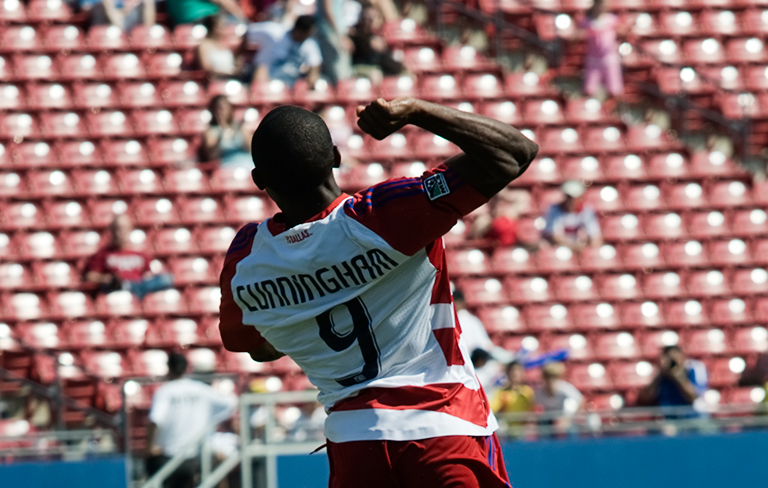
10 – The Man
This is the Big Cheese, the Big Kahuna, El Jefe, the Boss. Wearing the #10 is saying “this is my team.” Wearing the #10 means you will carry the load and the burden both on and off the field. The names on this jersey are the all-time greats of the game. Forward, attacking mid, central mid, playmaker, sweeper even.
Positionally, these days, “the 10” is what we call the attacking-mid or off-striker behind the #9, the playmaker.
World: Pele, Maradona, Lionel Messi, Zinedine Zidane (w/ France), Lothar Matthaus, Ronaldinho, Denis Law, Francesco Totti, Alessandro Del Piero, Roberto Baggio, Zico, Dennis Bergkamp, Rivaldo, Ferenc Puskas…
USA: Tab Ramos, Claudio Reyna, Landon Donovan, Christian Pulisic
MLS: Marco Etcheverry, Carlos Valderrama, Blanco, Landon Donovan, Giovani dos Santos, Sebastian Giovinco, Kaka
FCD: David Ferreira, Dante Washington, Joselito Vaca, Mauro Diaz, Ramon Nunez
Usage that makes my head hurt: Ricardo Iribarren once wore number 10 for the Dallas Burn as a marking back and cursed the franchise’s 10-jersey for years.

11 – The Slasher
The other forward, perhaps a wing or wide midfielder with an attacking bent. Started as the left winger and has stayed a winger/slashing kind of player. More left-sided.
World: Ryan Giggs, Didier Drogba, Robin Van Persie, Romario, Ángel Di María, Francisco Gento, Edgar Davids, Karl-Heinz Rummenigge, Miroslav Klose, Michael Laudrup
USA: Eric Wynalda, Brian Ching, Stuart Holden
MLS: Javier Morales, Alejandro Bedoya
FCD: Antonio Martinez, Damian Alvarez, Andre Rocha, Fabian Castillo, Santiago Mosquera
Usage that makes my head hurt: Clarence Goodson grew up a forward so he switched to the #11 as a center back when it became available with FC Dallas.
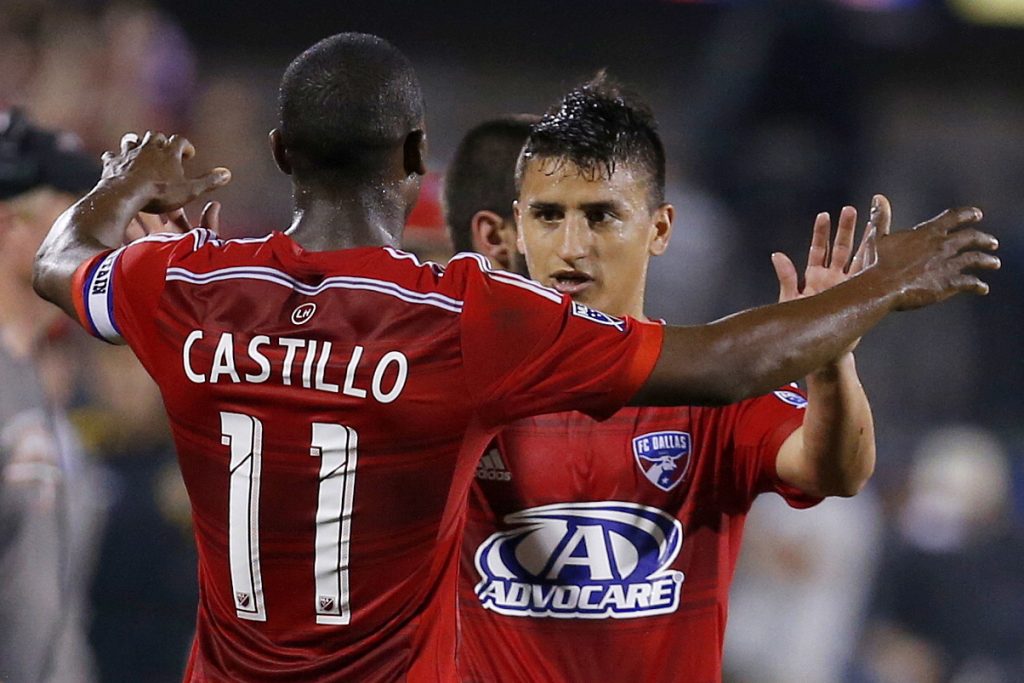
The Classic 1 to 11 Formation in the United States
All of this leaves us with something like this for our original 11 as we see them today… give or take. Sorta… Some people want to swap 4 and 3 but I don’t.
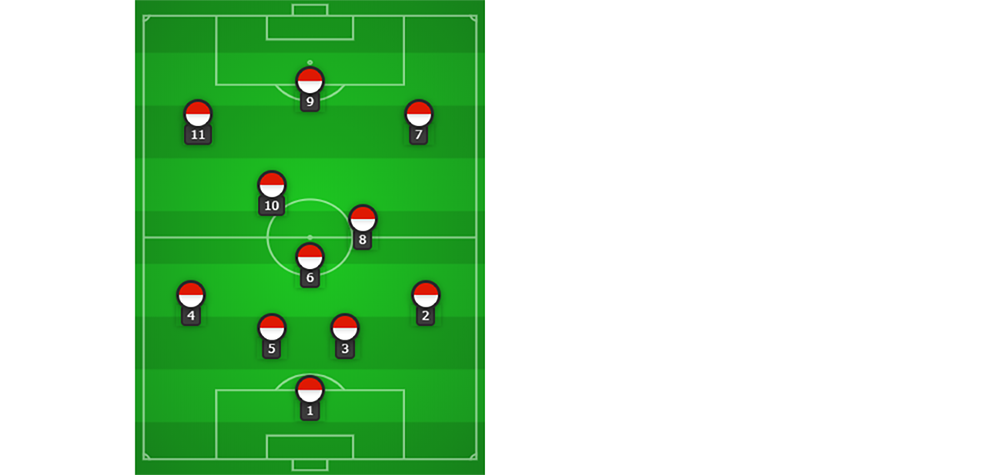
12 to 23
In the current era of 23-man international squads, the numbers 12 to 23 have become modern favorites and are sought after much more than they were, say, 15 to 20 years ago.
Positionally they tend to shift around a lot more than 1-11 as they don’t have a traditional tactical interpretation.
You could expand this section up to 25 or even 30 if you want as some leagues have number rules and squads that big.
La Liga in Spain, for example, requires senior professional players to wear numbers 1 to 25 with the keeper in 1, 13, or 25. In France, the roster is 1 to 30 with 1, 16, and 30 reserved for goalkeepers.
12 – High Impact
Traditionally the 12 was the first sub listed, which often meant the keeper in ages past.
Now the number twelve is a large contributor to the team, and in most recent years has begun to transform into an attacking style player and is a frequent starter in large squads. The 12 is sometimes chosen as double 6 (holding mid?) or as 2+10 (right back).
World: Marcelo Vieira (w/ Madrid), Olivier Giroud, Julio Cesar, Alex Sandro, Giovanni van Bronckhorst
USA: Jay DeMerit, Jimmy Conrad, Brad Guzan
MLS: Fredy Montero, Romell Quioto
FCD: Brandon Pollard, Jordan Stone, Arturo Alvarez, Eric Avila, Ryan Hollingshead
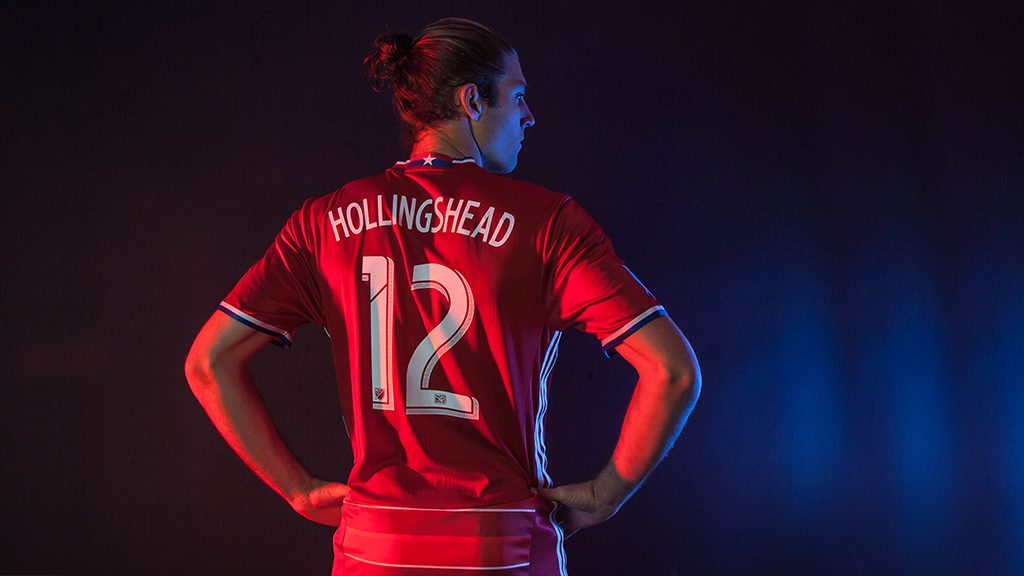
13 – Mr. Unlucky
A player with the mojo to wear the “unlucky 13″ and get away with it. A player that will throw their arrogance back in the face of fate and tell it to take a hike. Style, flash, brashness, guts, and attitude are hallmarks of the #13.
Often a midfielder and a second 10, if you will, except in Spain where the 13 is required by rule to be a keeper.
World: Michael Ballack, Alessandro Nesta, Maicon (w/ Inter), Eusebio (1966 World Cup), Thomas Muller, Gerd Muller, Rafinha
USA: Cobi Jones, Clint Mathis, Ricardo Clark, Jordan Morris.
FCD: Brian Haynes, Dax McCarty, Tesho Akindele, Zdenek Ondrasek
14 – The Brains
The fourteen is a class player, most often in the midfield, and usually, one that gets by with brains rather than brawn.
The 14 number became famous because of Johan Cruyff, the embodiment of total football. He switched to it in 1970, previously he had been 9.
FC Dallas side note: For FCD these players have a lot of grit and heart added in. It’s arguably the most influential number in club history.
World: Johan Cruyff, Jose Maria Guti, Thierry Henry (club), Xabi Alonso, Bobby Moffat
MLS: Chris Armas, Ben Olsen, Steve Ralston, Chad Marshall, Alex.
FCD: Leonel Alvarez, Ted Eck, Drew Moor, George John, Atiba Harris
FCD Side Story: This is the number FCD wanted to give to Simo Valakari when he joined the club because of the history of the number. Unfortunately, the soon-to-be-cut Gavin Glinton was wearing #14 and FCD hadn’t reached an injury settlement to clear Glinton off the roster by the time Valakari was added. So instead FCD gave Valakari #17.
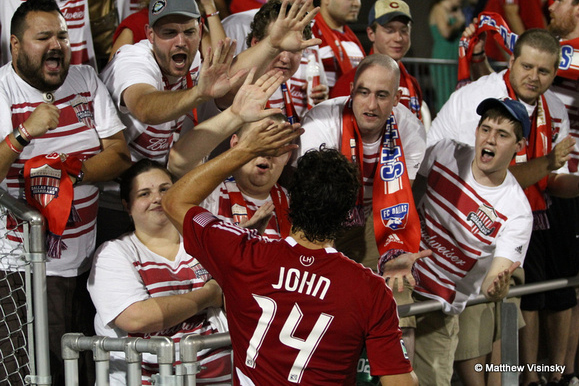
15 – Mr. Personality
For some reason 15 is often a player with a big personality, whether it is ego, toughness, or just general hubris. Not specifically linked to a position on the field.
World: Olivier Dacourt, Nemanja Vidić, Lilian Thuram, Mats Hummels, Daniel Sturridge
MLS: John Wolyniec, Jessee Marsch, Roy Lassiter, Thomas McNamara.
FCD: Chad Deering, Mark Wilson, Adrian Serioux, Jacori Hayes
16 & 17 – The Ten + Whatever
Nothing particularly sets these numbers apart except that they are often relatively desired numbers in the modern 23-man squad. Often chosen as ten + whatever number the player really wanted or simply as “any number under 20.”
These two numbers kick off a string of frequent striker numbers up to 20, but they can be used in other places.
In general terms, I feel like 16 tends slightly toward midfield as 6+10 while 17 tends toward attack as 7+10.
Contrary to that, for FC Dallas the 17 has been defensive.
In France, the 16 is reserved for a keeper.
16 – Sixteen
World: Roy Keane, Daniele de Rossi
USA: Benny Feilhaber
MLS: Josh Wolff, David Estrada
FCD: Alexy Korol, David Wagenfuhr, Bobby Warshaw, Ricardo Pepi
17 – Seventeen
World: David Trézéguet, Pedro, Alexis Sanchez, Kevin De Bruyne, Marek Hamsik, Jerome Boateng, Emmanuel Petit
USA: Juan Agudelo, Jozy Altidore
MLS: Chris Rolfe, Chris Wingert, Will Bruin
FCD: Zarco Rodriguez, Simo Valakari, Aaron Pitchkolan, Zach Loyd, Nkosi Tafari
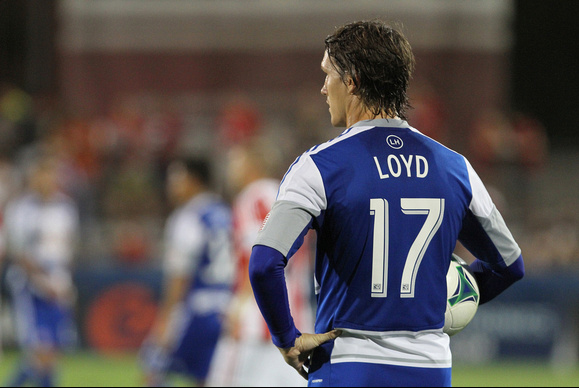
18 – The Double-9
#18 is usually, but not always, a striker or forward number. Most often chosen as 9+9.
Ivan Zamorano when he was with Inter used to put a little “+” between the 1 and the 8 to make 9. It’s also occasionally chosen as 10+8 for a creative or linking midfielder.
And in the USA it’s sometimes a keeper’s number. Perhaps because when rosters were at 18 it was the highest number? Or is it all because of Kasey Keller?
Field Players
World: Jurgen Klinsmann, Paul Scholes, Shaun Wright-Phillips (England), Lionel Messi (early days Argentina), Ivan Zamorano, Jordi Alba, Ashley Young
USA: Chris Wondolowski, CJ Sapong
MLS: Dom Dwyer
FCD: Richard Farrer, Richard Mulrooney, Toni Nhleko, Brandon Servania
Keepers
USA: Kasey Keller
MLS: Pat Onstad, Nick Rimando, Jon Busch, Matt Pickens, Chris Seitz (with FCD)
19 – Ten + Nine
Similar to the 18, the 19 is often chosen as 10+9.
Clinton Morrison while at Crystal Palace also put a little + between the 1 and the 9 on his jersey.
World: Lionel Messi (early days at Barcelona), Esteban Cambiasso, Mario Götze, Dwight Yorke, Leroy Sane
MLS: Chad Barrett, Dane Richards, Juninho
FCD: Bobby Rhine, Paxton Pomykal
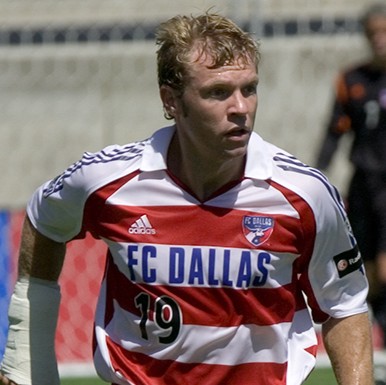
Side Note: At FC Dallas #19 is now a Homegrown only number to honor Bobby, currently worn by Paxton Pomykal.
20 – The Other 9
Rather than being thought of as a playmaker wearing 10×2, #20 is most frequently worn by someone who is a prototypical 9.
No. 20 was made popular as a striker number in 1982 by Paolo Rossi when he led Italy to the World Cup title as he scored six goals to win the Golden Boot and the Golden Ball. Italy handed out numbers from 1 to 22 in order from defender to striker for that tournament so all the forwards in the Italy squad wore 15 and up that year.
World: Deco, Paolo Rossi, Gonzalo Higuain (w/ Juve), Vava, Dele Alli, Ole Gunnar Solskjær, Oliver Bierhoff
USA: Brian McBride
MLS: Brian McBride, Taylor Twellman, Jack McInerney.
FCD: Carlos Ruiz, Brek Shea, Ronald Cerritos, Arial Graziani, Mickey Trotman.

21 – BlackJack
The odd duck of the first 23 numbers. If you see someone wearing 21 they were usually assigned #21 and then just don’t bother to change. Landon Donovan, for example, only wore it in the US squad until 10 opened up.
World: David Silva, Philipp Lahm, Andre Pirlo, Zinedine Zidane (w Juve)
USA: Landon Donovan (early days), Paul Arriola
MLS: Dema Kovalenko, Shalrie Joseph
FCD: Michael Barrios, Alex Yi, and a bunch of guys who quickly swapped out of it like Greg Vanney or Ramon Nunez
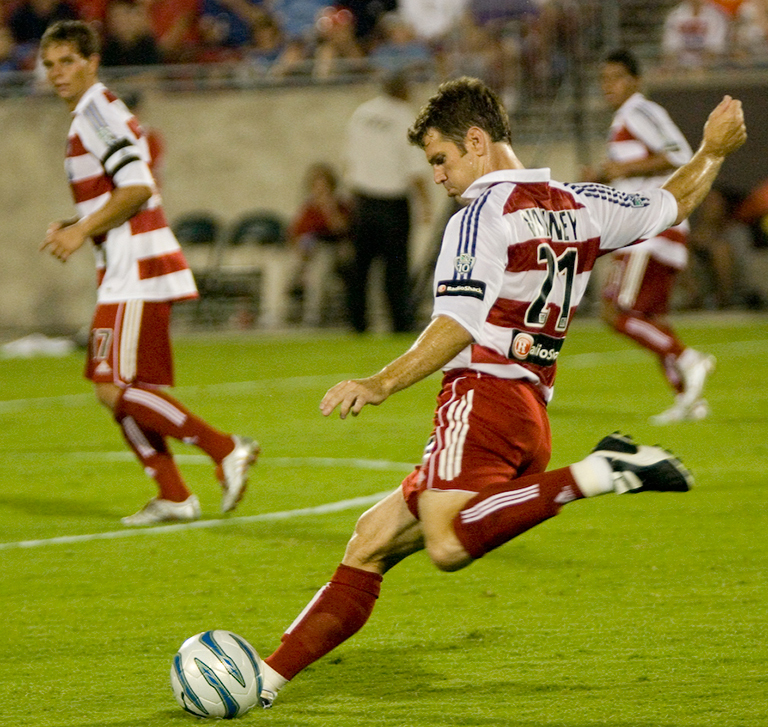
22 – The Lalas
The double 2, so more often than not a defender. Partially made famous in the states by Alexi Lalas.
It’s also often a keeper jersey, particularly for FC Dallas.
World: Kaka (AC Milan), Dani Alvez, Willian, Isco, Christian Pulisic
USA: Alexi Lalas
MLS: William Conde, Davy Arnaud, Ramiro Corrales, Marvell Wynne
FCD: Matt Jordan, Chris Snitko, DJ Countess, Josh Lambo
23 – The Beckham, a.k.a Michael Jordan
The last World Cup squad number prior to the 2022 roster expansion.
#23 was famously chosen by David Beckham when he went to Real Madrid to “honor Michael Jordan.” In reality, #7 at Real was taken by Mr. Madrid himself, Raul. So Beckham had to pick something else and 23 was available. Because of Beckham and Jordan, this is now a very popular number.
Traditionally in the 23-man international squads where it was the “extra” player added beyond 22 (i.e. two complete sets of 11) this number was frequently the 3rd keeper.
World: David Beckham (Madrid), Marco Materazzi, Jamie Carragher, Carlo Cudicini, Massimo Oddo, Massimo Ambrosini, Sol Campbell, Arturo Vidal
USA: Eddie Pope
MLS: David Beckham, Colin Clark, Ezra Hendrickson, Kei Kamara.
FCD: Blake Wagner, Sergi Daniv, Kellyn Acosta, Thomas Roberts

Usage that makes my head hurt: Stop wearing #23 for Beckham, wear the #7 and honor the world game. Beckham wore 23 after he “sold out” to the money and glamour of Madrid and then American hype. When he was a soccer player first – at Man U and with England – he wore 7.
You want to bend it like Beckham? Then wear 7.
And get off my lawn.
24 to 30 – The Large Squad
There is nothing in and of itself “wrong” with these numbers, they are a byproduct of larger squads over 23 players. In MLS these are primarily developmental squad numbers as the MLS “senior rosters” hold up to 20 players.
Often, these numbers are just handed out as what’s available, they certainly are with FC Dallas where young players don’t usually get to pick their numbers.
As squads around the world are bigger, and as players move more frequently, these higher numbers are being used more and more. Some of them have become famous both in MLS and around the world. Here are a few.
24 – Matt Hedges at FC Dallas, Tim Howard at Everton.
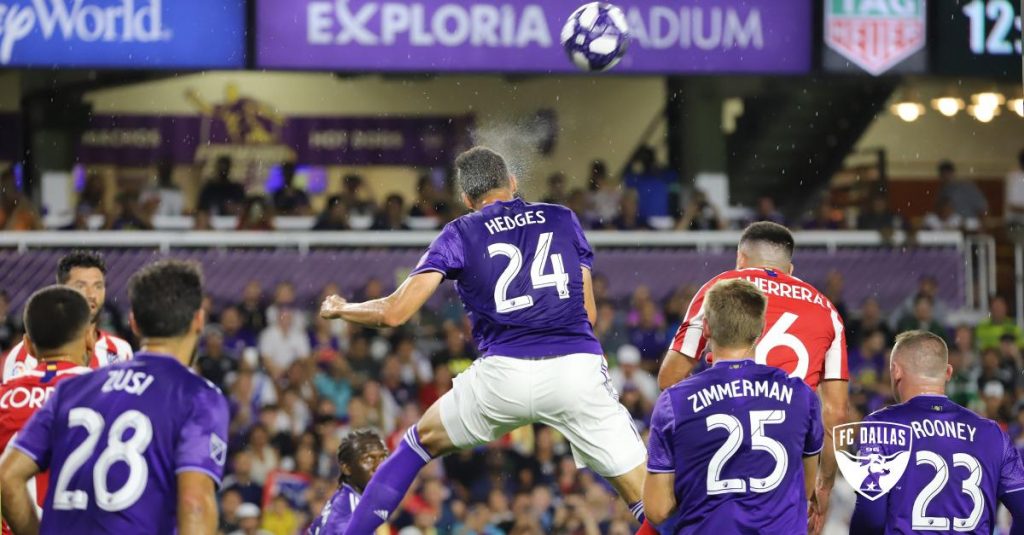
25 – Brian Ching, Antonio Valencia, Gianfranco Zola, Walker Zimmerman and, Callum Montgomery at FCD.
Required by rule to be a keeper in Spain.
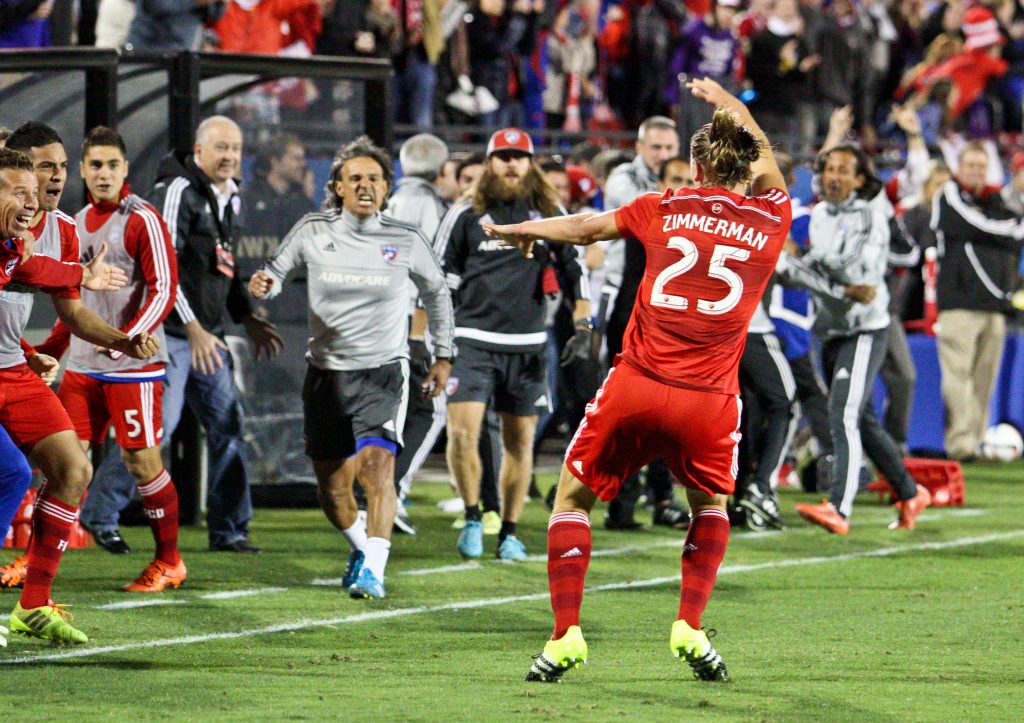
26 – John Terry. He chose it because it meant he got to sit next to #25 Gianfranco Zola in the locker room. Yes, seriously.
29 – Franco Jara. The Argentine striker requested the 29 the number he wore with Pachuca.
30 – Kyle Zobeck, Ray Burse, Maarten Paes.
30 is required by rule to be a goalkeeper in France. At FC Dallas the number has never been worn by a non-keeper and is usually the 3rd keeper’s kit.
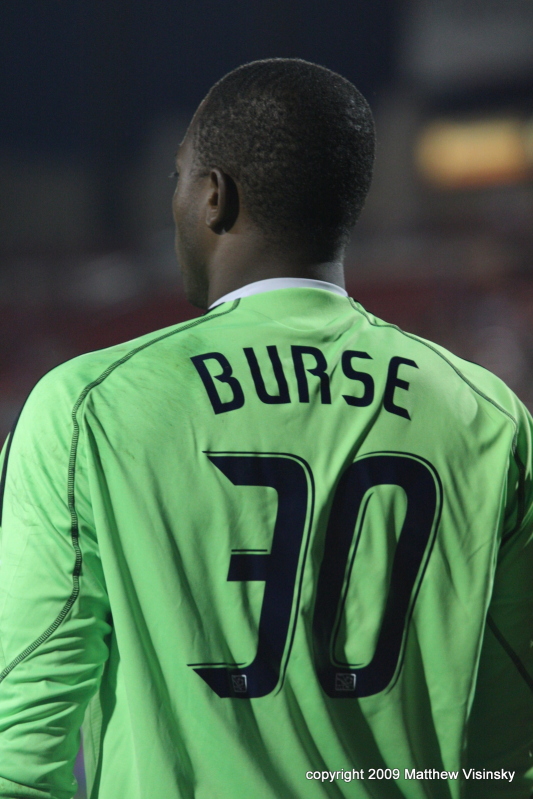
31 and Up – Oddities
There are the numbers that really stretch the upper limits of rosters. In massive clubs, they are needed, often for youth players or U21s who are called up. In MLS, they aren’t needed so much but they will still see them, much to my annoyance.
In very recent times I’ve come to believe some players are sometimes picking these numbers just to be odd. Anything above here pretty much makes my head hurt. I’m too old school, I hate numbers that are silly, goofy, funny, odd, or a joke… which describes pretty much anything above this.
31 – George Weah at Chelsea.
32 – David Beckham at AC Milan. The reverse of 23, obviously.
33 – Kenny Cooper.
This is the NFL number that you see more on kids than professionals. Cooper wore it because the 9 was taken, then his second choice 3 was taken… Cooper said he had previously worn 3 for a large part of his career to pay homage to a friend of his father.

37 – Maxi Urruti. He has worn this number all but one year of his career.

41 – Ted Eck. He swapped to #41 when Leonel Alvarez briefly returned to the Dallas Burn.
42 – Yaya Torre. The reverse of his number at Barcelona (24).
Also the ultimate answer to the question of life, the universe, and everything.
45 – Mario Balotelli. Inter Milan youth players wore between 36 and 50, he took 45 as 4+5 = 9… then he scored in all four games in which he wore the number… so he kept it for good luck.
44 & 48 – Dario Sala. Dario said he wore #48 to honor his wife’s father who wore it in college. He later switched to the #44 to honor someone else.

66 – Alain Sutter, when he played for Dallas he wore 66 as an homage to America and Route 66.
69 – Bixente Lizarazu
76 – Andriy Shevchenko at AC Milan. A “birth year” number.
77 – Andy Williams, Luka Dončić. When #7 is taken you double down. Lots of versions of this these days. 66, 88.
99 – The Gretzky.
Made famous by NHL legend Wayne Gretzky who chose it when he was a kid because he wanted the #9 to honor Gordie Howe and on his youth team someone already had the 9.
Like Gretzky, most people who wear 99 actually want 9. See Bradley Wright-Phillips or Ronaldo at AC Milan.
0 & 00 – Another Keeper
A keeper number, particularly in the US college system but occasionally even in MLS. These two numbers are very American as it’s a non-traditional world number.
Jeff Cassar wore 00 with FCD. Englishman Alex Stepney wore 0 with the Dallas Tornado in ’79 and ’80. Steve Zerhusen wore 00 with Fort Lauderdale Strikers in 1979 and ’80.

